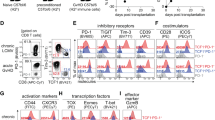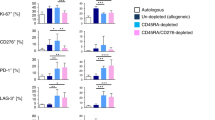Abstract
Adoptive immunotherapy with donor lymphocyte infusion (DLI) after allogeneic stem cell transplantation (alloSCT) may not only mediate Graft-versus-Leukemia (GvL) reactivity, but also induce Graft-versus-Host Disease (GvHD). As HLA-class II molecules are predominantly expressed on hematopoietic cells, CD4+ T cells may selectively mediate GvL reactivity without GvHD. Here, we assessed the capacity of human CD4+ T cells to act as sole mediators of GvL reactivity in a NOD/scid mouse model for human acute lymphoblastic leukemia and chronic myeloid leukemia in lymphoid blast crisis. Highly purified CD4+ DLI eradicated the leukemic cells. The anti-tumor immunity was mediated by a polyclonal CD4+ T cell response comprising cytokine-producing T-helper and cytolytic T-effector cells directed against the mismatched HLA-class II molecules of the patients. Furthermore, primary leukemic cells acquired an antigen-presenting cell (APC) phenotype in vivo after DLI, as well as in vitro after co-culture with leukemia-specific CD4+ T cells. In conclusion, our results show that CD4+ T cells can be strong mediators of anti-tumor immunity, and provide evidence that cross-talk between CD4+ T cells and leukemic cells is the basis for induction of leukemic cells with an APC phenotype. These data emphasize the clinical relevance of CD4+ T cell based immunotherapy as treatment modality for hematological malignancies after alloSCT.
This is a preview of subscription content, access via your institution
Access options
Subscribe to this journal
Receive 12 print issues and online access
$259.00 per year
only $21.58 per issue
Buy this article
- Purchase on Springer Link
- Instant access to full article PDF
Prices may be subject to local taxes which are calculated during checkout




Similar content being viewed by others
References
Marmont AM, Horowitz MM, Gale RP, Sobocinski K, Ash RC, van Bekkum DW et al. T cell depletion of HLA-identical transplants in leukemia. Blood 1991; 78: 2120–2130.
Barge RM, Starrenburg CW, Falkenburg JHF, Fibbe WE, Marijt EW, Willemze R . Long-term follow-up of myeloablative allogeneic stem cell transplantation using Campath ‘in the bag’ as T cell depletion: the Leiden experience. Bone Marrow Transplant 2006; 37: 1129–1134.
Collins Jr RH, Shpilberg O, Drobyski WR, Porter DL, Giralt S, Champlin R et al. Donor leukocyte infusions in 140 patients with relapsed malignancy after allogeneic bone marrow transplantation. J Clin Oncol 1997; 15: 433–444.
Porter DL, Collins Jr RH, Hardy C, Kernan NA, Drobyski WR, Giralt S et al. Treatment of relapsed leukemia after unrelated donor marrow transplantation with unrelated donor leukocyte infusions. Blood 2000; 95: 1214–1221.
Madrigal JA, Arguello R, Scott I, Avakian H . Molecular histocompatibility typing in unrelated donor bone marrow transplantation. Blood Rev 1997; 11: 105–117.
Collins T, Korman AJ, Wake CT, Boss JM, Kappes DJ et al. Immune interferon activates multiple class II major histocompatibility complex genes and the associated invariant chain gene in human endothelial cells and dermal fibroblasts. Proc Natl Acad Sci USA 1984; 81: 4917–4921.
Rutten CE, van Luxemburg-Heijs SAP, Griffioen M, Marijt EW, Jedema I, Heemskerk MHM et al. HLA-DP as specific target for cellular immunotherapy in HLA class II-expressing B-cell leukemia. Leukemia 2008; 22: 1387–1394.
Schoenberger SP, Toes RE, van d V, Offringa R, Melief CJ . T cell help for cytotoxic T lymphocytes is mediated by CD40-CD40 L interactions. Nature 1998; 393: 480–483.
Bennett SR, Carbone FR, Karamalis F, Flavell RA, Miller JF, Heath WR . Help for cytotoxic T cell responses is mediated by CD40 signalling. Nature 1998; 393: 478–480.
Ridge JP, Di RF, Matzinger P . A conditioned dendritic cell can be a temporal bridge between a CD4+ T-helper and a T-killer cell. Nature 1998; 393: 474–478.
Shedlock DJ, Shen H . Requirement for CD4 T cell help in generating functional CD8 T cell memory. Science 2003; 300: 337–339.
Faber LM, van Luxemburg-Heijs SAP, Veenhof WF, Willemze R, Falkenburg JHF . Generation of CD4+ cytotoxic T-lymphocyte clones from a patient with severe graft-versus-host disease after allogeneic bone marrow transplantation: implications for graft-versus-leukemia reactivity. Blood 1995; 86: 2821–2828.
Kloosterboer FM, van Luxemburg-Heijs SAP, van Soest RA, Barbui AM, van Egmond HM et al. Direct cloning of leukemia-reactive T cells from patients treated with donor lymphocyte infusion shows a relative dominance of hematopoiesis-restricted minor histocompatibility antigen HA-1 and HA-2 specific T cells. Leukemia 2004; 18: 798–808.
Griffioen M, van der Meijden ED, Slager EH, Honders MW, Rutten CE, van Luxemburg-Heijs SAP et al. Identification of phosphatidylinositol 4-kinase type II beta as HLA class II-restricted target in graft versus leukemia reactivity. Proc Natl Acad Sci USA 2008; 105: 3837–3842.
Nimer SD, Giorgi J, Gajewski JL, Ku N, Schiller GJ, Lee K et al. Selective depletion of CD8+ cells for prevention of graft-versus-host disease after bone marrow transplantation. A randomized controlled trial. Transplantation 1994; 57: 82–87.
Soiffer RJ, Alyea EP, Hochberg E, Wu C, Canning C, Parikh B et al. Randomized trial of CD8+ T cell depletion in the prevention of graft-versus-host disease associated with donor lymphocyte infusion. Biol Blood Marrow Transplant 2002; 8: 625–632.
Zorn E, Wang KS, Hochberg EP, Canning C, Alyea EP, Soiffer RJ et al. Infusion of CD4+ donor lymphocytes induces the expansion of CD8+ donor T cells with cytolytic activity directed against recipient hematopoietic cells. Clin Cancer Res 2002; 8: 2052–2060.
Kolb HJ, Schattenberg A, Goldman JM, Hertenstein B, Jacobsen N, Arcese W et al. Graft-versus-leukemia effect of donor lymphocyte transfusions in marrow grafted patients. Blood 1995; 86: 2041–2050.
Labeur MS, Roters B, Pers B, Mehling A, Luger TA, Schwarz T et al. Generation of tumor immunity by bone marrow-derived dendritic cells correlates with dendritic cell maturation stage. J Immunol 1999; 162: 168–175.
Smit WM, Rijnbeek M, van Bergen CAM, de Paus RA, Vervenne HA, van de Keur M et al. Generation of dendritic cells expressing bcr-abl from CD34-positive chronic myeloid leukemia precursor cells. Hum Immunol 1997; 53: 216–223.
Jedema I, Meij P, Steeneveld E, Hoogendoorn M, Nijmeijer BA, van de Meent M et al. Early detection and rapid isolation of leukemia-reactive donor T cells for adoptive transfer using the IFN-gamma secretion assay. Clin Cancer Res 2007; 13 (2 Part 1): 636–643.
Cignetti A, Bryant E, Allione B, Vitale A, Foa R, Cheever MA . CD34(+) acute myeloid and lymphoid leukemic blasts can be induced to differentiate into dendritic cells. Blood 1999; 94: 2048–2055.
Brouwer RE, van der Hoorn MAWG, Kluin-Nelemans HC, van Zelderen-Bhola S, Willemze R, Falkenburg JHF . The generation of dendritic-like cells with increased allostimulatory function from acute myeloid leukemia cells of various FAB subclasses. Hum Immunol 2000; 61: 565–574.
Hoogendoorn M, Wolbers JO, Smit WM, Schaafsma MR, Barge RM, Willemze R et al. Generation of B-cell chronic lymphocytic leukemia (B-CLL)-reactive T cell lines and clones from HLA class I-matched donors using modified B-CLL cells as stimulators: implications for adoptive immunotherapy. Leukemia 2004; 18: 1278–1287.
Nijmeijer BA, van Schie MLJ, Verzaal P, Willemze R, Falkenburg JHF . Responses to donor lymphocyte infusion for acute lymphoblastic leukemia may be determined by both qualitative and quantitative limitations of antileukemic T cell responses as observed in an animal model for human leukemia. Exp Hematol 2005; 33: 1172–1181.
Heemskerk MHM, Hoogeboom M, de Paus RA, Kester MG, van der Hoorn MA, Goulmy E et al. Redirection of antileukemic reactivity of peripheral T lymphocytes using gene transfer of minor histocompatibility antigen HA-2-specific T cell receptor complexes expressing a conserved alpha joining region. Blood 2003; 102: 3530–3540.
Griffioen M, van Egmond HM, Barnby-Porritt H, van der Hoorn MA, Hagedoorn RS, Kester MG et al. Genetic engineering of virus-specific T cells with T cell receptors recognizing minor histocompatibility antigens for clinical application. Haematologica 2008; 93: 1535–1543.
Rutten CE, van Luxemburg-Heijs SAP, van der Meijden ED, Griffioen M, Oudshoorn M, Willemze R et al. HLA-DPB1 mismatching results in the generation of a full repertoire of HLA-DPB1 specific CD4+ T cell responses showing immunogenicity of all HLA-DPB1 alleles. Biol.Blood Marrow Transplant 2010; 16: 1282–1292.
Stumpf AN, van der Meijden ED, van Bergen CAM, Willemze R, Falkenburg JHF, Griffioen M . Identification of 4 new HLA-DR-restricted minor histocompatibility antigens as hematopoietic targets in antitumor immunity. Blood 2009; 114: 3684–3692.
Rutten CE, van Luxemburg-Heijs SAP, van der Meijden ED, Griffioen M, Oudshoorn M, Willemze R et al. Both permissive and nonpermissive HLA-DPB1 mismatches can induce polyclonal HLA-DPB1 specific immune responses in vivo and in vitro. Blood 2010; 115: 151–153.
Petersdorf EW . Optimal HLA matching in hematopoietic cell transplantation. Curr Opin Immunol 2008; 20: 588–593.
Petersdorf EW, Kollman C, Hurley CK, Dupont B, Nademanee A et al. Effect of HLA class II gene disparity on clinical outcome in unrelated donor hematopoietic cell transplantation for chronic myeloid leukemia: the US National Marrow Donor Program Experience. Blood 2001; 98: 2922–2929.
Flomenberg N, Baxter-Lowe LA, Confer D, Fernandez-Vina M, Filipovich A et al. Impact of HLA class I and class II high-resolution matching on outcomes of unrelated donor bone marrow transplantation: HLA-C mismatching is associated with a strong adverse effect on transplantation outcome. Blood 2004; 104: 1923–1930.
Chalandon Y, Tiercy JM, Schanz U, Gungor T, Seger R et al. Impact of high-resolution matching in allogeneic unrelated donor stem cell transplantation in Switzerland. Bone Marrow Transplant 2006; 37: 909–916.
Lee SJ, Klein J, Haagenson M, Baxter-Lowe LA, Confer DL, Eapen M et al. High-resolution donor-recipient HLA matching contributes to the success of unrelated donor marrow transplantation. Blood 2007; 110: 4576–4583.
Acknowledgements
We thank ED van der Meijden (Leiden University Medical Center, Department of Hematology) for generation of HLA-DQ constructs. This study was supported by grant 2008-4263 from the Dutch Cancer Society.
Author information
Authors and Affiliations
Corresponding author
Ethics declarations
Competing interests
The authors declare no conflict of interest.
Additional information
Supplementary Information accompanies the paper on the Leukemia website
Rights and permissions
About this article
Cite this article
Stevanović, S., Griffioen, M., Nijmeijer, B. et al. Human allo-reactive CD4+ T cells as strong mediators of anti-tumor immunity in NOD/scid mice engrafted with human acute lymphoblastic leukemia. Leukemia 26, 312–322 (2012). https://doi.org/10.1038/leu.2011.222
Received:
Revised:
Accepted:
Published:
Issue Date:
DOI: https://doi.org/10.1038/leu.2011.222
Keywords
This article is cited by
-
HLA-DPB1 mismatch alleles represent powerful leukemia rejection antigens in CD4 T-cell immunotherapy after allogeneic stem-cell transplantation
Leukemia (2017)
-
HLA-class II disparity is necessary for effective T cell mediated Graft-versus-Leukemia effects in NOD/scid mice engrafted with human acute lymphoblastic leukemia
Leukemia (2013)



